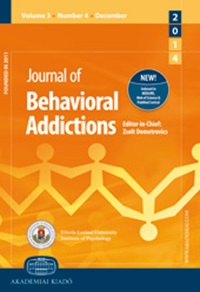青少年早期家庭功能障碍和问题游戏的恶性循环以及自我概念清晰度的中介作用:一项使用随机截距交叉滞后面板模型的个人分析
IF 6.6
1区 医学
Q1 PSYCHIATRY
引用次数: 0
摘要
背景与目的家庭功能障碍是青少年问题游戏的重要危险因素,但家庭功能障碍变化与青少年问题游戏的双向关系及其可能的中介机制研究较少。本研究旨在探讨家庭功能障碍与青少年问题游戏之间的双向关系,以及自我概念清晰度在这种关系中的中介作用。方法纳入4731名中国早期青少年(44.9%为女孩;M年龄= 10.91岁,SD = 0.72),分别于4个时间点(间隔6个月)进行调查。随机截取交叉滞后面板模型发现:(a)家庭功能障碍直接预测问题游戏的增加,(b)青少年问题游戏直接预测家庭功能障碍的增加,(c)家庭功能障碍通过自我概念清晰度间接预测问题游戏,(d)青少年问题游戏通过自我概念清晰度间接预测家庭功能障碍。讨论与结论本研究表明,青少年可能会直接或间接地通过损害自我概念清晰度而陷入家庭功能障碍与问题游戏之间的恶性循环。研究结果表明,培养青少年自我概念的清晰度对于打破家庭功能失调经历与青少年问题游戏之间的恶性循环至关重要。本文章由计算机程序翻译,如有差异,请以英文原文为准。
The vicious cycle of family dysfunction and problematic gaming and the mediating role of self-concept clarity among early adolescents: A within-person analysis using random intercept cross-lagged panel modeling
Abstract Backgrounds and aims Family dysfunction is a significant risk factor for adolescent problematic gaming, yet few studies have investigated the bidirectional relations between changes in family dysfunction and adolescent problematic gaming and potential mediating mechanisms. This study thus examined the bidirectional relations between family dysfunction and adolescent problematic gaming and the mediating role of self-concept clarity within this relation. Methods Participants included 4,731 Chinese early adolescents (44.9% girls; M age = 10.91 years, SD = 0.72) who were surveyed at four time points 6 months apart. Results Random intercept cross-lagged panel modeling found (a) family dysfunction directly predicts increased problematic gaming, (b) adolescent problematic gaming directly predicts increased experience of family dysfunction, (c) family dysfunction indirectly predicts problematic gaming via self-concept clarity, and (d) adolescent problematic gaming indirectly predicts family dysfunction via self-concept clarity. Discussion and conclusions The present study suggests that adolescents may be trapped in a vicious cycle between family dysfunction and problematic gaming either directly or indirectly through impairing their self-concept clarity. Findings indicate fostering youth self-concept clarity is essential to break the vicious circle between dysfunctional experiences in the family and problematic gaming among adolescents.
求助全文
通过发布文献求助,成功后即可免费获取论文全文。
去求助
来源期刊

Journal of Behavioral Addictions
PSYCHIATRY-
CiteScore
12.30
自引率
7.70%
发文量
91
审稿时长
20 weeks
期刊介绍:
The aim of Journal of Behavioral Addictions is to create a forum for the scientific information exchange with regard to behavioral addictions. The journal is a broad focused interdisciplinary one that publishes manuscripts on different approaches of non-substance addictions, research reports focusing on the addictive patterns of various behaviors, especially disorders of the impulsive-compulsive spectrum, and also publishes reviews in these topics. Coverage ranges from genetic and neurobiological research through psychological and clinical psychiatric approaches to epidemiological, sociological and anthropological aspects.
 求助内容:
求助内容: 应助结果提醒方式:
应助结果提醒方式:


